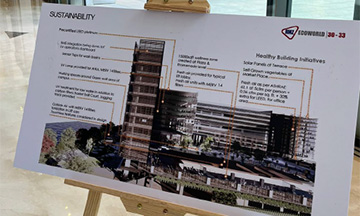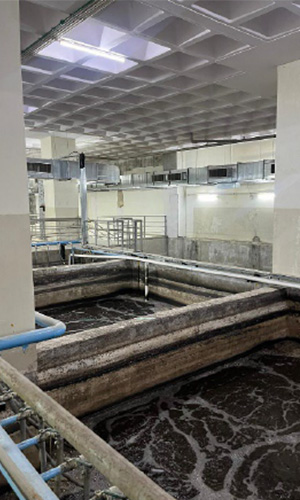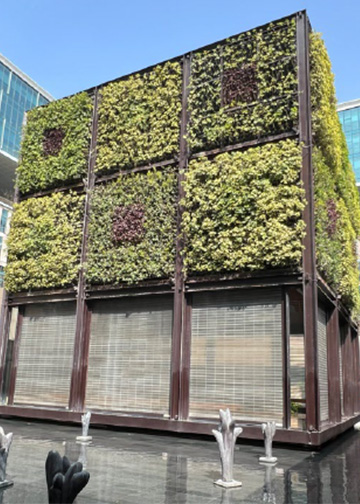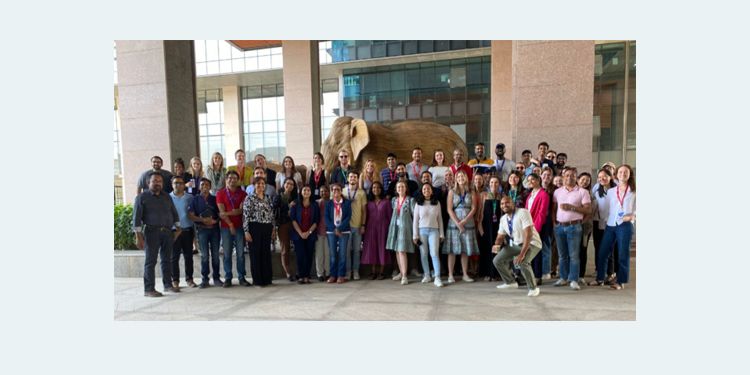Professor Vikram Gandhi’s Immersive Field Course (IFC) “Development while Decarbonizing: India’s Path to Net-Zero" delved into the critical aspect of decarbonization and sustainability goals amid India's rapid development. The course presented an opportunity for students to advance their knowledge of sustainability efforts, decarbonization, and net zero in the context of a broader development agenda. The class culminated in a series of site visits in January 2024 in Mumbai and Bangalore and this is one of 14 student essays that highlights their reflections on uncovering sustainable solutions across the country.
On January 15th, 2024 we had the opportunity to visit EcoWorld, a 7.5 million square feet commercial development in Bangalore as part of the 2024 immersive field course on India’s path to decarbonization (see Figure 1). While buildings are a significant driver of global emissions (up to 40%), India will require significant continued development to cater for its growing economy and population over the coming decades. Therefore, this site visit offered tremendous insight on one of India’s most significant, yet hard-to-decarbonize sectors.

About EcoWorld
Development of EcoWorld began in 2016 by Indian real estate firm RMZ to accommodate Bangalore’s increasing need for office space, particularly for tech firms. Accordingly, the development was designed to be a state-of-the-art facility that merges work and social spaces. In addition to 6.7 million square feet of office space rented by companies like Honeywell and KPMG, EcoWorld features 134 thousand square feet of retail and other public spaces. During our tour, we saw first-hand how these public spaces were designed to foster community, embrace Bangalore’s temperate climate, and inspire through beautiful art displays. For example, at the center of one of EcoWorld’s many buildings stands a massive, completely carbon neutral cube, designed to create a space to connect with others and embrace nature (see Figure 2). Another part of the development featured wooden elephants that appeared to be walking through one of the common areas (see Figure 3). Throughout EcoWorld, restaurants and retail spaces fostered additional ways for members of the public to connect outside of work.
Sustainability at EcoWorld
Due to its scale, RMZ had to meet extensive government requirements on sustainability when building EcoWorld. One of these requirements was in-house sewage treatment plant, which we had the opportunity to see during our tour (see Figure 4). Our tour also emphasized that RMZ targets going above and beyond requirements regarding its operational carbon footprint. For example, we had the opportunity to see many of the innovative ways that EcoWorld leverages nature to optimize energy efficiency. Massive sliding doors that integrate indoor and outdoor spaces and leverage natural cooling were prevalent throughout the development. Moreover, a lake was developed behind the property to encourage cool winds and buildings are strategically positioned to allow wind tunnels that keep common areas up to 4 degrees Celsius cooler than outdoor temperatures, supported by an evaporative cooling system. These innovations allow the development to limit air conditioning use to the three hottest months of the year. Rain harvesting, building design to minimize lighting, shifts toward renewable energy, and cutting-edge waste management are other examples of how RMZ minimizes its operating footprint.

Key Takeaways from Site Visit:
Continued lack of incentives and tracking for embodied emissions:
While EcoWorld was full of cutting-edge innovations to minimize the carbon footprint of its operations (see Figure 5), the approach to reducing embodied emissions was less clear. Embodied emissions include the carbon required to build a development. This includes materials, like steel and cement, as well as energy to support the building process. RMZ has a target to reduce embodied carbon by 44% in new developments, but they expressed that the path to this goal is complicated by lack of data on upstream emissions from suppliers, as well as the reality of steel and cement being “hard-to-decarbonize” materials that are inherently reliant on carbon. Therefore, progress on this goal will likely require partnership with upstream suppliers to improve tracking and heightened ability to absorb increased building material costs, whether through an increased premium on green real estate or government incentives.

Importance of downstream pressure to incent sustainable investment:
Throughout our site visit, it was clear that RMZ had invested significant incremental capital to make EcoWorld as sustainable as possible. This was surprising, given our understanding of the “split incentives” problem in green buildings: the party responsible for emissions-reducing investments (developers) are often unable to capture the savings of those investments, since tenants are typically responsible for operational energy costs. However, RMZ articulated that they are still able to justify investments in sustainability because it commands a “green premium” from its customers to the tune of 10-15% gross rent (which translates to +75 bps on earnings multiple). Many of EcoWorld’s tenants are massive multinational companies with sustainability targets due to various regulatory requirements and/or consumer pressure. These targets enable them to justify paying higher rent for a more sustainable building. This finding highlighted the impact that consumer pressure and company targets can have on sustainable investment across the world.

Contrast with residential real estate decarbonization:
While the EcoWorld visit inspired a lot of hope on decarbonizing commercial real estate, it also highlighted the elevated challenge ahead in decarbonizing residential buildings. Residential building emissions represent over half of total building emissions and are only likely to increase as Indian prosperity improves and air conditioning adoption increases. As previously mentioned, large corporates are incentivized and able to pay premiums for green buildings, but this is not the case for most Indian consumers. Other site visits during our trip highlighted the income inequality and poverty that, while improving, continues to be prominent in India. This makes it difficult to justify expensive investments to reduce emissions. As a result, decarbonizing the residential sector will require a combination of innovation on affordable sustainable solutions (such as cleaner cooking technologies) as well as government subsidies and regulations to make these technologies more accessible.


